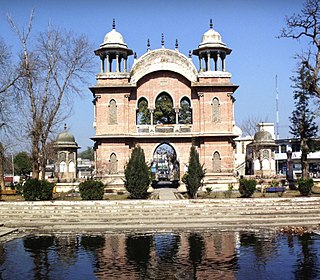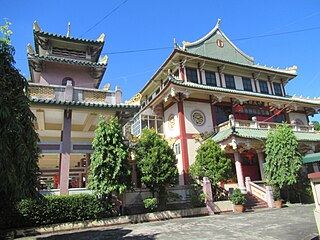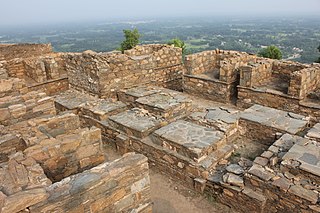Related Research Articles

The Greco-Buddhist art or Gandhara art is the artistic manifestation of Greco-Buddhism, a cultural syncretism between Ancient Greek art and Buddhism. It had mainly evolved in the ancient region of Gandhara, located in the northwestern fringe of the Indian subcontinent.

Haripur is a historical city in Hazara Division of Khyber Pakhtunkhwa Pakistan. With Swabi and Buner to the west, some 65 km (40 mi) north of Islamabad and 35 km Khanpur Road Tofkian Valley Taxila and 35 km (22 mi) south of Abbottabad. It is in a hilly plain area at an altitude of 520 m (1,706 ft).

Mes Aynak, also called Mis Ainak or Mis-e-Ainak, was a major Buddhist settlement 40 km (25 mi) southeast of Kabul, Afghanistan, located in a barren region of Logar Province. The site is also the location of Afghanistan's largest copper deposit.

Mardān is a city in the Mardan District of Khyber Pakhtunkhwa Province, Pakistan. Located in the Valley of Peshawar, Mardan is the second-largest city of Khyber Pakhtunkhwa. It is a fast-growing city that experienced a population boom in the latter half of the twentieth century.

The Lahore Museum is a museum located in Lahore, Punjab, Pakistan. Founded in 1865 at a smaller location and opened in 1894 at its current location on The Mall in Lahore during the British colonial period, Lahore Museum is Pakistan's largest museum, as well as one of its most visited ones.

Patna Museum is the state museum of the Indian state of Bihar. Founded on 3 April 1917 during the British Raj to house the historical artefacts found in the vicinity of Patna, it is constructed in the style of Mughal and Rajput architecture, and is known locally as the Jadu Ghar. Artefacts from the ancient India era to 1764 have now been transferred to Bihar Museum.

The Pyu city-states were a group of city-states that existed from about the 2nd century BCE to the mid-11th century in present-day Upper Myanmar (Burma). The city-states were founded as part of the southward migration by the Tibeto-Burman-speaking Pyu people, the earliest inhabitants of Burma of whom records are extant. The thousand-year period, often referred to as the Pyu millennium, linked the Bronze Age to the beginning of the classical states period when the Pagan Kingdom emerged in the late 9th century.

Buddhism is a minor religion in the Philippines. It is practiced by 2% of the population in 2020, primarily by Filipinos of Chinese descent.
The Lower Swat Valley in Swat and Lower Dir Districts in Pakistan is an area of important archeological sites.

The Peshawar Museum is a museum located in Peshawar, capital of Pakistan's Khyber Pakhtunkhwa province. The Peshawar Museum is notable for its collection of Buddhist artwork dating from the ancient Gandhara region.
Malananta was an Indian Buddhist monk and missionary from Swabi who brought Buddhism to the southern Korean peninsula in the 4th century. Multiple romanizations of Malananta's name may be found, including Meghananda (मेघानंदा), Malananda, Maranant'a and Maalaananda. He was among the first to bring Buddhist teaching, or Dharma, to Korea. The Samguk yusa and Samguk yusa record him as the one who brought Buddhism to King Chimnyu of Baekje in 384 CE, along with Sundo in Goguryeo and Ado in Silla. Buddhism, a religion originating in what is now India, was transmitted to Korea via China in the late 4th century.

Buddhism in Pakistan took root in the third century BCE under the Mauryan king Ashoka. The Major Rock Edicts of Ashoka inscribed on rock boulders in Mansehra and Shahbaz Garhi written in the Kharosthi script recording aspects of the emperor's dharma or righteous law represent some of the earliest evidence of deciphered writing in South Asia, dating to middle of the third century BCE. The Indo-Greek king Menander embraced Buddhism as attested in the Milinda Panha, which dates from sometime between 100 BC and 200 AD, following a dialogue with the monk Nāgasena in Sagala, present-day Sialkot.

Government Museum and Art Gallery, Chandigarh, is a premier museum of North India having collections of Gandharan sculptures, sculptures from ancient and medieval India, Pahari and Rajasthani miniature paintings. It owes its existence to the partition of India in August, 1947. Prior to the partition, much of the collections of art objects, paintings and sculptures present here were housed in the Central Museum, Lahore, the then capital of Punjab. The museum has one of the largest collection of Gandharan artefacts in the world.

Ranigat is a collection of 2nd-century CE Buddhist ruins spread over an area of 4 square kilometers that dates from the Gandhara civilization. Ranigat is located in the Buner Valley of Pakistan's Khyber Pakhtunkhwa province.

Located on the strategic crossroads of Iran, India, China and Central Asia, Afghanistan boasts a diverse cultural and religious history. The soil is rich with archaeological treasures and art that have for decades come under threat of destruction and damage. Archaeology of Afghanistan, mainly conducted by British and French antiquarians, has had a heavy focus on the treasure filled Buddhist monasteries that lined the silk road from the 1st c. BCE – 6th c. AD. Particularly the ancient civilizations in the region during the Hellenistic period and the Kushan Empire. The world's oldest-known oil paintings, dating to the 7th c. AD, were found in caves in Afghanistan's Bamiyan Valley. The valley is also home to the famous Buddhas of Bamiyan.

Jamal Garhi is a small town located 13 kilometers from Mardan at Katlang-Mardan road in Khyber Pakhtunkhwa province in northern Pakistan. Jamal Garhi was a Buddhist monastery from the first until the fifth century AD at a time when Buddhism flourished in this part of the Indian subcontinent. The monastery and main stupa are surrounded by chapels closely packed together. The site is called "The Jamal Garhi Kandarat or Kafiro Kote" by the locals.
Pilak is an archaeological site in the Santirbazar sub-division of South Tripura district of the Indian state of Tripura. Many images and structures, belonging to Buddhist and Hindu sects, have been discovered here since 1927. The antiquities found here are dated to 8th to 12th centuries.

Chandavaram Buddhist site is an ancient Indian Buddhist site in Chandavaram village in Prakasam district in the Indian state of Andhra Pradesh. Situated on the bank of Gundlakamma River, the site is 10 kilometres (6.2 mi) northwest of Donakonda railway station. The Chandavaram Buddhist site was built between the 2nd century BCE and the 2nd century CE during the Satavahana dynasty and was discovered by Veluri Venkata Krishna Sastry in 1964.

Swat Museum is a museum located in Mingora, on the road connecting Mingora and Saidu Sharif in the Swat District of the Khyber Pakhtunkhwa province of Pakistan.

Hund Museum is an archaeology museum located in Hund, near the bank of the Indus River north of Attock, Swabi district, Khyber Pakhtunkhwa, Pakistan. It is frequented by thousands of visitors annually.
References
- ↑ "Ancient Buddha artifacts found in Swabi". February 15, 2022.
- ↑ "Ancient Buddha artifacts found in Pakistan". www.aa.com.tr. Retrieved 2022-02-21.
- ↑ Agency, Anadolu (February 15, 2022). "1,800-year-old Buddha artifacts unearthed in Pakistan". Daily Sabah.
- ↑ "Rare Buddhist artefacts unearthed in Pakistan". Rare Buddhist artefacts unearthed in Pakistan.